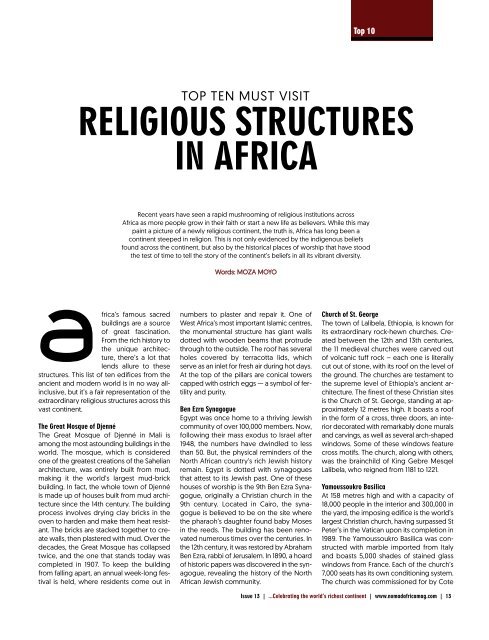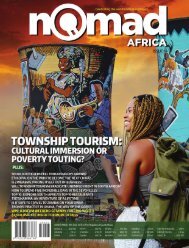Nomad Africa Edition 13
This edition of the magazine presents us with an opportunity to deeply look into faith-based tourism and churches across the continent of Africa. Reports of pastors convincing worshipers to eat snakes, spraying insecticide into mouths of believers during fully packed sermons under the guise of God’s hand apparently, and even buildings that collapse due to poor structural engineering – there has been much strange activity, but no consequence. This makes us ask a single question; should churches not be regulated? (see page 76). Lorraine Masemola – a new addition to our editorial team, attended the Domba traditional dance of magical Venda in South Africa. This colourful python dance, held annually at a very sacred site, Lake Fundudzi, secures good rain for the following season (page 52). In another special feature, Martin Chemhere, in his piece, updates us on South Africa’s newly relaxed visa regulations. Will it significantly help boost tourism in that country? (page 62). To this extent, I will like to say that I am delighted to work with the talented team here at Nomad Africa as I assume the position as the new Managing Editor. It was a daunting idea to build something new in travel journalism - something brave, bold and exceptionally beautiful. Africa’s future is an open road and we’re picking up speed, so it is the perfect time to be joining. Good writing and engaging storytelling are the lenses through which we connect with the world. I look forward to exploring the various cultures, people, developments and trends impacting Africa’s travel and tourism industry. At a time when most online content tends toward the shallow and ephemeral, our stories will seek to deliver sustained engagement and value. As I work with the team to grow the company into a sustainable publisher of smart stories, dynamic insights and carefully curated thought leadership, I hope you find it resourceful and compelling. I am grateful to re-imagine every single page with you. I look forward to the journey. I hope you enjoy the ride with us.
This edition of the magazine presents us with an opportunity to deeply look into faith-based tourism and churches across the continent of Africa. Reports of pastors convincing worshipers to eat snakes, spraying insecticide into mouths of believers during fully packed sermons under the guise of God’s hand apparently, and even buildings that collapse due to poor structural engineering – there has been much strange activity, but no consequence. This makes us ask a single question; should churches not be regulated? (see page 76).
Lorraine Masemola – a new addition to our editorial team, attended the Domba traditional dance of magical Venda in South Africa. This colourful python dance, held annually at a very sacred site, Lake Fundudzi, secures good rain for the following season (page 52). In another special feature, Martin Chemhere, in his piece, updates us on South Africa’s newly relaxed visa regulations. Will it significantly help boost tourism in that country? (page 62).
To this extent, I will like to say that I am delighted to work with the talented team here at Nomad Africa as I assume the position as the new Managing Editor. It was a daunting idea to build something new in travel journalism - something brave, bold and exceptionally beautiful. Africa’s future is an open road and we’re picking up speed, so it is the perfect time to be joining.
Good writing and engaging storytelling are the lenses through which we connect with the world. I look forward to exploring the various cultures, people, developments and trends impacting Africa’s travel and tourism industry. At a time when most online content tends toward the shallow and ephemeral, our stories will seek to deliver sustained engagement and value. As I work with the team to grow the company into a sustainable publisher of smart stories, dynamic insights and carefully curated thought leadership,
I hope you find it resourceful and compelling. I am grateful to re-imagine every
single page with you. I look forward to the journey. I hope you enjoy the ride with us.
You also want an ePaper? Increase the reach of your titles
YUMPU automatically turns print PDFs into web optimized ePapers that Google loves.
Top 10<br />
TOP TEN MUST VISIT<br />
RELIGIOUS STRUCTURES<br />
IN AFRICA<br />
Recent years have seen a rapid mushrooming of religious institutions across<br />
<strong>Africa</strong> as more people grow in their faith or start a new life as believers. While this may<br />
paint a picture of a newly religious continent, the truth is, <strong>Africa</strong> has long been a<br />
continent steeped in religion. This is not only evidenced by the indigenous beliefs<br />
found across the continent, but also by the historical places of worship that have stood<br />
the test of time to tell the story of the continent’s beliefs in all its vibrant diversity.<br />
Words: MOZA MOYO<br />
africa’s famous sacred<br />
buildings are a source<br />
of great fascination.<br />
From the rich history to<br />
the unique architecture,<br />
there’s a lot that<br />
lends allure to these<br />
structures. This list of ten edifices from the<br />
ancient and modern world is in no way allinclusive,<br />
but it’s a fair representation of the<br />
extraordinary religious structures across this<br />
vast continent.<br />
The Great Mosque of Djenné<br />
The Great Mosque of Djenné in Mali is<br />
among the most astounding buildings in the<br />
world. The mosque, which is considered<br />
one of the greatest creations of the Sahelian<br />
architecture, was entirely built from mud,<br />
making it the world’s largest mud-brick<br />
building. In fact, the whole town of Djenné<br />
is made up of houses built from mud architecture<br />
since the 14th century. The building<br />
process involves drying clay bricks in the<br />
oven to harden and make them heat resistant.<br />
The bricks are stacked together to create<br />
walls, then plastered with mud. Over the<br />
decades, the Great Mosque has collapsed<br />
twice, and the one that stands today was<br />
completed in 1907. To keep the building<br />
from falling apart, an annual week-long festival<br />
is held, where residents come out in<br />
numbers to plaster and repair it. One of<br />
West <strong>Africa</strong>’s most important Islamic centres,<br />
the monumental structure has giant walls<br />
dotted with wooden beams that protrude<br />
through to the outside. The roof has several<br />
holes covered by terracotta lids, which<br />
serve as an inlet for fresh air during hot days.<br />
At the top of the pillars are conical towers<br />
capped with ostrich eggs — a symbol of fertility<br />
and purity.<br />
Ben Ezra Synagogue<br />
Egypt was once home to a thriving Jewish<br />
community of over 100,000 members. Now,<br />
following their mass exodus to Israel after<br />
1948, the numbers have dwindled to less<br />
than 50. But, the physical reminders of the<br />
North <strong>Africa</strong>n country’s rich Jewish history<br />
remain. Egypt is dotted with synagogues<br />
that attest to its Jewish past. One of these<br />
houses of worship is the 9th Ben Ezra Synagogue,<br />
originally a Christian church in the<br />
9th century. Located in Cairo, the synagogue<br />
is believed to be on the site where<br />
the pharaoh’s daughter found baby Moses<br />
in the reeds. The building has been renovated<br />
numerous times over the centuries. In<br />
the 12th century, it was restored by Abraham<br />
Ben Ezra, rabbi of Jerusalem. In 1890, a hoard<br />
of historic papers was discovered in the synagogue,<br />
revealing the history of the North<br />
<strong>Africa</strong>n Jewish community.<br />
Church of St. George<br />
The town of Lalibela, Ethiopia, is known for<br />
its extraordinary rock-hewn churches. Created<br />
between the 12th and <strong>13</strong>th centuries,<br />
the 11 medieval churches were carved out<br />
of volcanic tuff rock – each one is literally<br />
cut out of stone, with its roof on the level of<br />
the ground. The churches are testament to<br />
the supreme level of Ethiopia’s ancient architecture.<br />
The finest of these Christian sites<br />
is the Church of St. George, standing at approximately<br />
12 metres high. It boasts a roof<br />
in the form of a cross, three doors, an interior<br />
decorated with remarkably done murals<br />
and carvings, as well as several arch-shaped<br />
windows. Some of these windows feature<br />
cross motifs. The church, along with others,<br />
was the brainchild of King Gebre Mesqel<br />
Lalibela, who reigned from 1181 to 1221.<br />
Yamoussoukro Basilica<br />
At 158 metres high and with a capacity of<br />
18,000 people in the interior and 300,000 in<br />
the yard, the imposing edifice is the world’s<br />
largest Christian church, having surpassed St<br />
Peter’s in the Vatican upon its completion in<br />
1989. The Yamoussoukro Basilica was constructed<br />
with marble imported from Italy<br />
and boasts 5,000 shades of stained glass<br />
windows from France. Each of the church’s<br />
7,000 seats has its own conditioning system.<br />
The church was commissioned for by Cote<br />
Issue <strong>13</strong> | ...Celebrating the world’s richest continent | www.nomadafricamag.com | <strong>13</strong>





